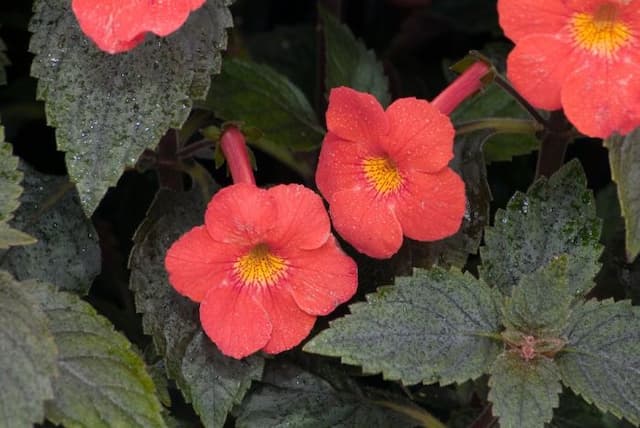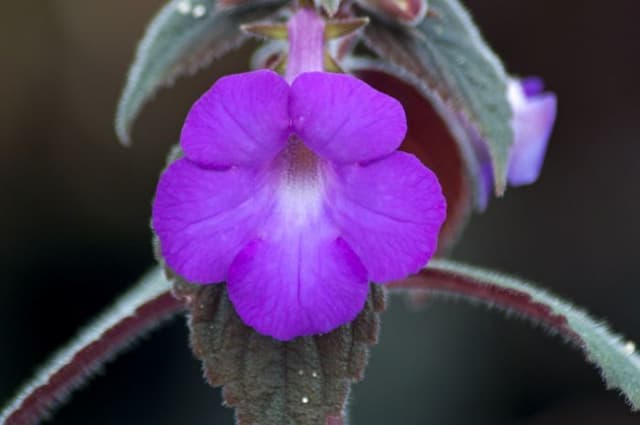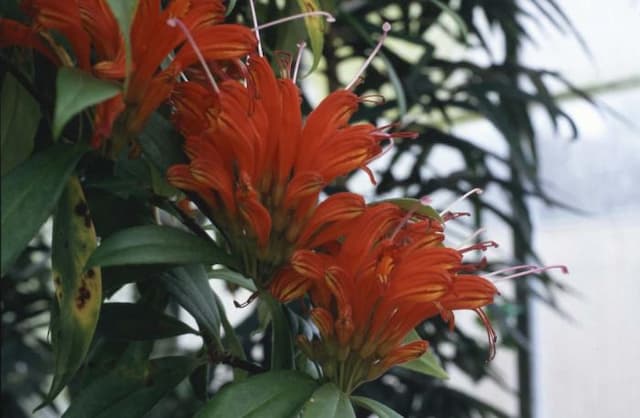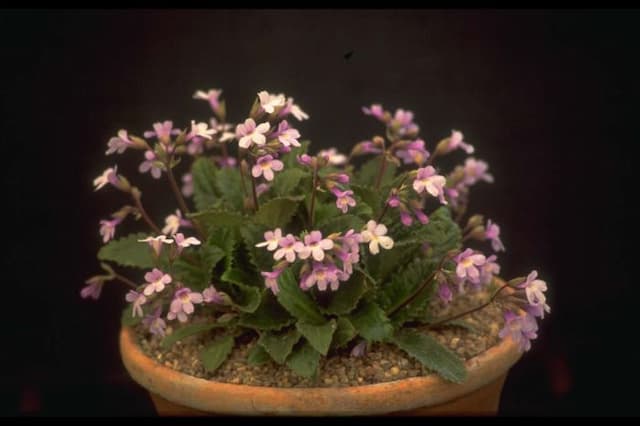Cape Primrose Streptocarpus 'Albatross'

ABOUT
Streptocarpus 'Albatross', commonly known as Cape Primrose, is a flowering plant that displays a rosette of dark green, velvety leaves which are long and narrow with a soft, fuzzy texture. These leaves often have a slightly wavy edge, adding to their decorative appearance. Emerging on slender stalks from the base of the plant, the flowers of the Cape Primrose are its most striking feature. The 'Albatross' variety boasts large, trumpet-shaped blooms that are white with a hint of pale blue, particularly towards the petal edges, and they frequently showcase a vibrant yellow throat, adding a splash of color and contrast to the delicate white petals. As with many members of the Cape Primrose family, the flower exhibits a bilateral symmetry, meaning it is mirror-imaged on either side, which accentuates the flower's ornate pattern.
About this plant
 Names
NamesFamily
Gesneriaceae
Synonyms
Cape Primrose, African Violet Cousin
Common names
Streptocarpus 'Albatross'.
 Toxicity
ToxicityTo humans
Cape primrose (Streptocarpus 'Albatross') is generally considered to be non-toxic to humans. There are no well-documented toxic effects reported for ingestion of the plant. However, as with any non-food plant, ingestion of large quantities could potentially cause stomach discomfort or an allergic reaction in sensitive individuals. It is always prudent to keep plants out of the reach of children who might ingest them out of curiosity.
To pets
Cape primrose is also considered to be non-toxic to pets. It is not known to cause any serious symptoms of poisoning if pets ingest parts of the plant. However, ingestion of non-food items can sometimes lead to gastrointestinal upset in animals, such as vomiting or diarrhea. If your pet consumes a significant amount of the plant and you notice any signs of distress, it would be wise to consult with a veterinarian.
 Characteristics
CharacteristicsLife cycle
Perennials
Foliage type
Evergreen
Color of leaves
Varies
Flower color
White
Height
1 foot (30 centimeters
Spread
1 foot (30 centimeters
Plant type
Herb
Hardiness zones
10
Native area
Africa
Benefits
 General Benefits
General Benefits- Low Maintenance: Streptocarpus 'Albatross' does not require frequent watering or complicated care routines, making it ideal for those with a busy lifestyle or less experience in gardening.
- Long Blooming Period: This plant often has a continuous bloom cycle, providing color and vibrancy in your home or garden for extended periods throughout the year.
- Compact Growth: With its compact growing habit, Streptocarpus 'Albatross' is suitable for smaller spaces such as apartments or small garden beds.
- Variety of Colors: Streptocarpus 'Albatross' blooms come in a variety of colors, adding a beautiful and diverse aesthetic to any plant collection.
- Indoor and Outdoor Versatility: It can thrive both indoors as a houseplant and outdoors in mild climates, giving multiple options for placement.
- Non-Toxic to Pets: This plant is considered non-toxic, making it a safe choice for households with pets.
 Medical Properties
Medical PropertiesThis plant is not used for medical purposes.
 Air-purifying Qualities
Air-purifying QualitiesThis plant is not specifically known for air purifying qualities.
 Other Uses
Other Uses- Photographic subjects: The large, showy flowers of the Cape primrose make it an attractive plant for photographers, especially those specializing in botanical or nature photography.
- Artistic inspiration: Artists may use Cape primrose as a subject for drawing, painting, or other visual arts due to its striking blooms and foliage.
- Theme gardens: Garden designers may integrate Cape primrose into fairy gardens, Victorian-themed gardens, or other stylized landscape designs due to its quaint and decorative appearance.
- Educational tools: In educational settings, the Cape primrose can be used to teach botany and plant biology, demonstrating flower structure, plant growth, and pollination strategies.
- Crafting: The blossoms and leaves of the Cape primrose can be used in crafting, such as for making flower pressing or botanical prints.
- Culinary decoration: Though not commonly consumed, its flowers can be used as an organic decoration for cakes and pastries if properly identified and ensured to be pesticide-free.
- Color inspiration: The varied and vivid colors of Cape primrose blooms provide a natural palette for interior decorators and designers seeking color inspiration for projects.
- Space renovations: When potted in attractive containers, Cape primroses can add a pop of color to brighten up small spaces, bookshelves, or office desks.
- Science projects: Students may use Cape primrose in experiments to learn about the effects of different fertilizers, watering frequencies, or light conditions on plant growth.
- Container gardening education: Cape primrose is suitable for container gardening, making it an ideal example for educational workshops on how to care for potted plants.
Interesting Facts
 Feng Shui
Feng ShuiThe Cape Primrose is not used in Feng Shui practice.
 Zodiac Sign Compitability
Zodiac Sign CompitabilityThe Cape Primrose is not used in astrology practice.
 Plant Symbolism
Plant Symbolism- Resilience: Streptocarpus, commonly known as Cape Primrose, often symbolizes resilience for its ability to thrive under varying light conditions.
- Persistence: This plant's long-lasting blooms are associated with persistence, representing the trait of enduring in the face of challenges.
- Diversity: The wide variety of colors and patterns in Cape Primroses can symbolize diversity and the beauty of different forms coming together.
- Adaptability: As Cape Primrose adapts well to indoor environments, it can represent adaptability and the ability to prosper in different settings.
 Water
WaterCape primrose should be watered when the top inch of soil feels dry to the touch. Generally, this means watering about once a week, but frequency can vary based on the humidity and temperature of your home. When watering, use room temperature water and pour it evenly around the base of the plant, allowing the soil to become moist but not soggy. Avoid letting water sit in the saucer underneath the plant, as this can lead to root rot. They typically need about 8-16 ounces of water each time, depending on the size of the pot.
 Light
LightCape primrose thrives in bright, indirect light. A north-facing window or an east-facing window that provides morning light is ideal. Avoid direct sunlight, especially during the hot afternoon hours, as it can scorch the leaves and fade the flowers. If natural light is insufficient, a grow light can supplement the plant's light needs.
 Temperature
TemperatureCape primrose prefers a consistent temperature range between 60 and 75 degrees Fahrenheit. It can survive minimum temperatures of about 50 degrees Fahrenheit but should not be exposed to temperatures below this, as it can cause harm to the plant. Ideal temperatures during the day are in the mid-70s, and a slight drop in temperature at night is beneficial.
 Pruning
PruningPrune Cape primrose to remove any yellowing or dead leaves and spent blooms to encourage new growth and flowering. This is best done after a flowering cycle or as needed when growth appears untidy. The best time for extensive pruning is in the spring, but light pruning and deadheading can be performed throughout the growing season as necessary.
 Cleaning
CleaningAs needed
 Soil
SoilCape Primrose (Streptocarpus 'Albatross') prefers a well-draining soil mix rich in organic matter. A good mix can be made from 1 part peat, 1 part perlite, and 1 part vermiculite, to which some fine bark can be added. A slightly acidic to neutral pH of 6.0-7.0 is ideal for this plant.
 Repotting
RepottingCape Primrose should be repotted every 12-18 months using fresh soil mix to prevent compaction and replenish nutrients. Repot in spring or after the blooming period, choosing a pot only slightly larger than the previous one to protect its delicate roots.
 Humidity & Misting
Humidity & MistingCape Primrose requires moderate to high humidity, ideally between 50% and 70%, for optimal growth. Avoid placing it near heating vents or other dry air sources as it thrives in a more humid environment.
 Suitable locations
Suitable locationsIndoor
Place Cape Primrose in bright, indirect light and keep soil moist.
Outdoor
Keep Cape Primrose in shade and protect from direct sun and frost.
Hardiness zone
10-11 USDA
 Life cycle
Life cycleThe life cycle of the Streptocarpus 'Albatross', commonly known as Cape Primrose, begins with seed germination, which occurs in moist, well-drained soil with partial shade conditions. Upon germination, the plant develops a rosette of leaves and enters a vegetative growth phase, during which it establishes a strong root system and abundant foliage. As it matures, the Cape Primrose starts to produce flower stalks from the base of the leaves, leading to the flowering stage where large, trumpet-shaped flowers bloom, typically in shades of blue, purple or white. After successful pollination, typically by insects, the flowers produce seed capsules that, when dry, split open to release numerous tiny seeds. These seeds can be collected and sown to propagate new plants, or they may self-sow in conducive environments, continuing the cycle. The plant can live several years, with some species being able to survive mild winters to re-bloom in subsequent growing seasons, though cultivation practices often treat them as annual or biennial.
 Propogation
PropogationPropogation time
Spring to Summer
The Streptocarpus 'Albatross', commonly known as Cape Primrose, is generally propagated by leaf cuttings. The best time for this is during the warmer months, from spring to early autumn, when growth is more vigorous. To propagate, a healthy leaf is chosen and sliced across the main vein, creating several sections with a vein in each. These leaf pieces are then placed vein-side down into a moist, well-draining potting mix. Covering the pot with a plastic bag to retain humidity can encourage rooting. Within a few weeks to a couple of months, new plants will emerge at the vein cuts. Once new growth is evident and the plants have developed a robust root system, they can be potted on into individual containers.









